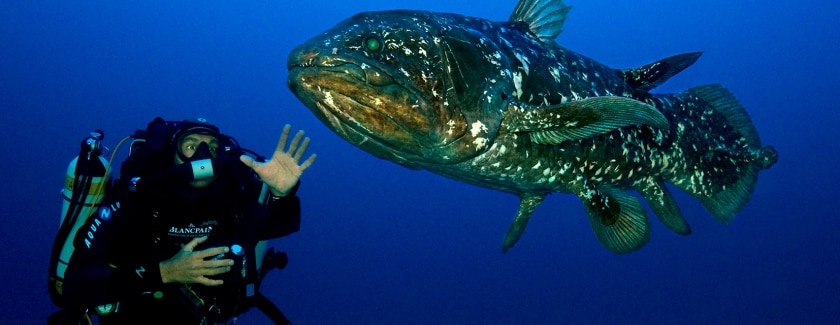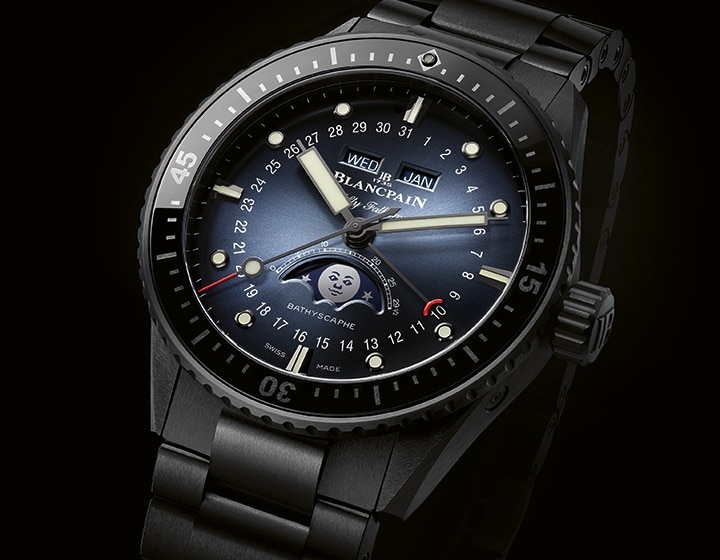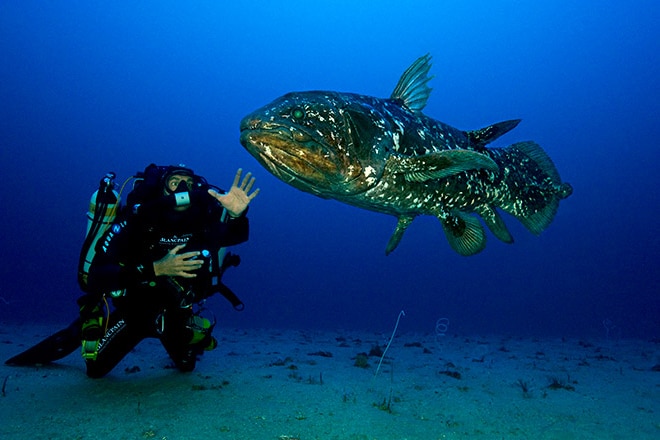Blancpain supports the Gombessa Project

Scientific expedition and encounter with the coelacanth
Last April 5th, globally renowned diver and naturalist Laurent Ballesta, equipped with a Blancpain Fifty Fathoms timepiece on his wrist and accompanied by specially trained divers and researchers from the South African Institute for Aquatic Biodiversity SAIAB, together with ten scientists from the Museum of National History and from CNRS, the French National Research Institute, all left for South Africa to undergo 40 days of deep water diving to meet with legendary bottom-dwelling sea creature, the coelacanth.
Locally known as Gombessa, this peaceful giant measures two meters long and was once thought to have become extinct 70 million years ago. However, this rare fish, when discovered alive in 1938 has come to represent one of the most important zoological discoveries of the 20th century: It is seen as the «transition animal» from backboned fish to the earliest four-legged vertebrate land animals; and with its lobe fins and «primitive lung», this fish bears testament to our forays within the primordial soup, 379 million years ago.
For over a century, the coelacanth has sparked intense debate between scientists and creationists. Portrayed as the crucial link between fish and land animals, it is without doubt one of the most hotly dissected and debated creatures of our time, and yet we know almost nothing about its way of life. Extremely rare and living over 100 meters deep, very few direct sightings have been witnessed until now. The Gombessa expedition, the result of two years’ scientific research, logistical and human preparedness, for the first time enabled observations and scientific experiments to be carried out in contact with a living coelacanth.
To reach this living legend, Laurent Ballesta and his team of divers had to perform daily deep water dives to Jesser Canyon caves, 120 meters below the surface: a depth where each minute passed underwater is paid for in long hours of decompression.
Once in contact with the animal, they implemented scientific protocol devised by the research team from the National History Museum and from CNRS, led by Professor Gaël Clément, paleontologist at the Museum, and by South African biologists, Kerry Sink and Angus Paterson from SAIAB.
Related news

Blancpain Grande Double Sonnerie
Seemingly impossible when the idea was spawned, the Grande Double Sonnerie has become a reality and a watchmaking first. This new Blancpain two melody grande sonnerie, petite sonnerie and minute repeater has been combined with a flying tourbillon and retrograde perpetual calendar, truly breaking new ground in the world of grand complications…

Blancpain Fifty Fathoms
Born from an icon that has shaped the history of watchmaking, the Fifty Fathoms Automatique 42mm in stainless steel joins Blancpain's permanent collection. Following the success of the 2023 limited edition, the Fifty Fathoms 70th Anniversary Act 1, and the brushed grade 23 titanium and red gold versions launched last year, this new model pays…

Blancpain Bathyscaphe Quantième Complet Phases de Lune
Blancpain is delighted to present the new Bathyscaphe Quantième Complet Phases de Lune, now fitted with an elaborately designed and patented black ceramic bracelet and a case made from the same material. With an assertive, sporty yet supremely elegant style, this model features a dial in vibrant shades of sunray-brushed blue. Available with a…



